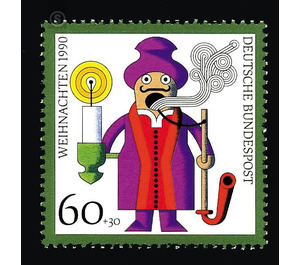Christmas - Germany / Federal Republic of Germany 1990 - 60 Pfennig
| Country | Germany / Federal Republic of Germany |
| Issue Date | 1990 |
| Face Value | 60.00 |
| Color | multi-colored green white |
| Perforation | K 13 3/4 |
| Printing Type | Multicolor offset printing |
| Stamp Type | Postage stamp |
| Item Type | Stamp |
| Chronological Issue Number | 1358 |
| Chronological Chapter | GER-BRD |
| SID | 647390 |
| In 37 Wishlists | |
This year's Christmas presents Christmas crafts, as it is traditionally offered on our Christmas markets. Christmas has moved the Christians for centuries and was made by Martin Luther the feast of bestowal, because previously they gave each other on New Year. Thus, the change in the tradition of the Nuremberg Christmas market is associated, which has opened for decades a girl dressed as a baby Jesus with a prologue from the balcony of the Frauenkirche. The assistant characters are children dressed like the noise gel angel. The Rauschgoldengel, formerly also referred to by mouth as "Engala", has a long tradition in Nuremberg dating back to the second half of the 18th century. His former appearance is associated with the clothing of the Nuremberg Kronenbraut, that is, the wedding attire of patrician daughters or the Franconian costume. However, the name refers to the material from which these angels were made, namely brass sheet beaten or rolled in thin sheets, called a gold rush. The form of such an angel pictured on the stamp goes back to the design of a renewed 1944 Rauschgoldengelfigur, which is now regarded as classic. Characteristic are the pleated skirt with the border and the skirt over it, the triangular bib with the side cut fringes, the large wings and the top cut in crown. In an illustration of the "Christbescheeren" by Joseph Kellner, Nuremberg in 1788, such an angelic figure holds candles in his hands. This angel of light has a counterpart in the older Engelbergmann. Both are an integral part of the Christmas tradition of the Erzgebirge. In the darkness of the long winter nights, these two Lightbringer were much sought after. So they liked to put them in the windows, one angel per girl in the family and one miner per boy. The shape shown on the stamp has the Zackenkrone echoes of the usual forms in Nuremberg, but otherwise the figure is entirely out of the spread in the Erzgebirge Drechselkunst out. On another stamp even the smoker is executed as a light bringer, which however represents a rare formation of the also mostly from the Erzgebirge originating Christmas companions. The turned-up incense smokers exude perfumes through incense candles lit in their interior and thus fulfill the Christmas parlor. Turks, hunters, artisans, students, fine people, but also types such as the Rastelbinder are among the people of these incense figures, the z. B. also in Berchtesgaden were and are. The figure of the nutcracker was also taken up in various toy manufacturing areas, for example in Val Gardena, in the Ore Mountains and in Thuringia, where the figure of Napoleon was especially popular (see the stamp). Since in former times the authorities were very hated, they took revenge on them with the nutcrackers by condemning them to cracking nuts. This lot met u. a. Policemen, kings, hunters, foresters or soldiers. So they are in contrast to the cozy smokey and lovable appearances of smokers, because it is said of them "The toy maker - who created me - made cracking a job ...". The first edition of Nutcracker after the picture book "King Nutcracker and poor Reinhold" (1851, Frankfurt, by Dr. Heinrich Hoffmann, the author of Struwwelpeter) was confiscated for alleged lese majeste. Nowadays, these pleasing Christmas figures have become widely used and popular. Thus, the smaller representations on the stamps will carry the word of a piece of Christmas culture all over the world. (Text: Dr. Lydia Bayer - Toy Museum of the City of Nuremberg)


